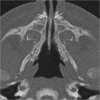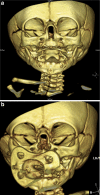Congenital nasal pyriform aperture stenosis: diagnosis and management
- PMID: 22731387
- PMCID: PMC3574011
- DOI: 10.1186/1824-7288-38-28
Congenital nasal pyriform aperture stenosis: diagnosis and management
Abstract
Background: Congenital nasal pyriform aperture stenosis is a rare and potentially lethal form of airway obstruction in newborns. Immediate recognition and appropriate therapy are mandatory for this potentially life-threating condition. This anomaly may present as an isolated malformation or may be associated with other cranial-facial anomalies. Clinically, CNPS shows unspecific symptoms of nasal airway obstruction such as apnoic crisis, episodic cyanosis and inability to nurse. The purpose of this report is to present author's experience in the surgical management of this rare pathology in 3 patients.
Patients and methods: Three cases of congenital nasal pyriform aperture stenosis were reviewed for presentation of the disorder, management and effectiveness of the surgical treatment.
Results: All the patients underwent a surgical correction of the pyriform aperture stenosis using a sublabial approach followed by nasal stenting. During the follow-up no cases of restenosis, respiratory failure or cyanosis were detected.
Conclusions: Congenital pyriform aperture stenosis should be suspected in newborns with clinical signs of severe nasal obstruction associated with a difficulty to pass a small catheter though the anterior nasal valve. Timely recognition is mandatory to prevent a potential deadly outcome. Surgical correction of the stenosis though a sublabial approach followed by a nasal stenting revealed to be most effective treatment for these patients.
Figures





References
-
- Brown OE, Myer CM, Manning SC. Congenital Nasal pyriform aperture stenosis. Laryngoscope. 1989;99:86–91. - PubMed
-
- Pereira K, Wang B. Congenital nasal pyriform aperture stenosis. Operative te chniques in Otolaryngology. 2005;16:194–197. doi: 10.1016/j.otot.2005.08.002. - DOI
-
- Burnstein FD, Cohen SR. Pyriform aperture stenosis: a rare case of neonatal airway obstruction. Ann Plast Surg. 1994;34:56. - PubMed
-
- Losken A, Burstein FD, Williams JK. Congenital nasal pyriform aperture stenosis: diagnosis and treatment. Plast Reconstr Surg. 2002;15:1506–1510. - PubMed
Publication types
MeSH terms
LinkOut - more resources
Full Text Sources

